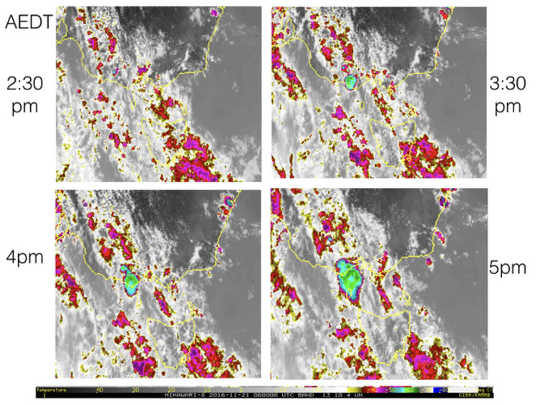
A recent thunderstorm asthma event has led some people to question what made this hay fever season so bad and how this tragic event occurred.
Thunderstorm asthma, a sudden surge in cases of acute respiratory illness coinciding with local thunderstorms, ranges from small events that affect handfuls of people to large-scale epidemics that impact a whole city and severely strain the capacity of emergency services.
Thunderstorm asthma occurs when a complex interaction of meteorological and biological factors affects a group of susceptible individuals.
We don’t yet know the clinical circumstances and allergic sensitivities of those who sought medical care on the night of the recent episode. But, based on similar events in Australia, most will likely have been allergic to grass pollen, in particular rye grass pollen.
Studies of previous Melbourne thunderstorm asthma events favoured grass pollen as the cause, rather than other possible triggers such as dust particles. Elsewhere, fungal spores have been implicated.
Another aspect of these events is that generally around a third of the affected people have no previous experience of asthma. This elevates anxiety in the community and complicates management and patient advice.
What’s the outlook?
While severe thunderstorm asthma epidemics are uncommon, there is no guarantee they will remain so. There is more grass pollen in years with high winter and spring rainfall and this past spring rainfall was exceptionally high across much of Australia. Victoria was no exception.
While it has been the worst grass pollen season we’ve seen for a few years, it could have been a lot worse.
The main source of Melbourne’s grass pollen is pastures to the city’s north and west. Warm north and north-westerly winds carry this pollen into the city. Keeping a lid on the current season has been Melbourne’s cooler-than-average November and southerly pollen-free winds from Bass Strait.
Paradoxically, thunderstorm asthma can occur in dry years as well as wet ones. Despite below-average rainfall in 2003, Melbourne still had an episode of thunderstorm asthma.
One of the main drivers of higher rainfall in Australia is a weather pattern called La Nina. Recent modelling points to an increased frequency of extreme La Nina events, from one roughly every 23 years in the 20th century, to one every 13 years this century.
Also of concern is the possibility of plants producing pollen that is more allergenic because the atmosphere contains more CO? or days are warmer.
By contrast, there is a mixed outlook in coming decades for meteorological factors that may contribute to thunderstorm asthma.
 Satellite images showing the thunderstorm that hit Melbourne on November 21 2016 and how it developed over the day. The green area represents very cold cloud-top temperatures of the thunderstorm complex over Melbourne. Regional and Mesoscale Meteorology Branch (RAMMB) of NOAA/NESDIS/Supplied, Author provided
Satellite images showing the thunderstorm that hit Melbourne on November 21 2016 and how it developed over the day. The green area represents very cold cloud-top temperatures of the thunderstorm complex over Melbourne. Regional and Mesoscale Meteorology Branch (RAMMB) of NOAA/NESDIS/Supplied, Author provided
Although rainfall totals across much of southern Australia are projected to decline (particularly during winter and spring), the frequency of severe thunderstorms is likely to increase.
Considering all these factors, it would be imprudent to dismiss the recent catastrophic episode of thunderstorm asthma as a “freak event” that is unlikely to reoccur.
An integrated approach to pollen forecasting
Forecasting the levels and types of pollen across Australia is one way for us to better understand, predict and mitigate thunderstorm asthma epidemics.
AusPollen, a team of researchers and stakeholders involved in providing care and education to those affected, will measure and provide information on grass pollen levels in Melbourne, Canberra, Sydney and Brisbane over the next three years. The information will be provided directly to the public via apps tailored to their city.
This information will then be used to develop a system to forecast the load and distribution of grass pollen. Strong partnership between researchers, allergy and respiratory doctors, Asthma Australia and government departments is needed to help public health authorities put in place warning systems for those at risk.
What can patients do now?
People with hay fever are advised to take their condition seriously. They should start by seeking support from a pharmacist or GP to manage their condition with over-the-counter medications (anti-histamines and/or intranasal corticosteroids).
If symptoms remain troublesome or affect your breathing, then seek medical advice. Allergen immunotherapy can be effective in managing grass pollen allergy and reducing the risk of asthma.
Those with known asthma are advised to use their medications as prescribed by their doctor. Particularly be careful to use an asthma preventer appropriately to keep symptoms under control. Ensure you have an asthma action plan and consult your doctor for regular assessment and ongoing management.
![]()
About The Author
Ed Newbigin, Associate Professor of Botany, University of Melbourne; Alfredo Huete, Professor, Climate Change Cluster, University of Technology Sydney; Beth Ebert, Research program leader for Weather and Environmental Prediction, Bureau of Meteorology R&D Branch, Australian Bureau of Meteorology; Janet Davies, Associate professor, Queensland University of Technology; Jeremy Silver, Postdoctoral research fellow, University of Melbourne, and Paul Beggs, Environmental Health Scientist, Macquarie University
This article was originally published on The Conversation. Read the original article.
Related Books:
at InnerSelf Market and Amazon
























